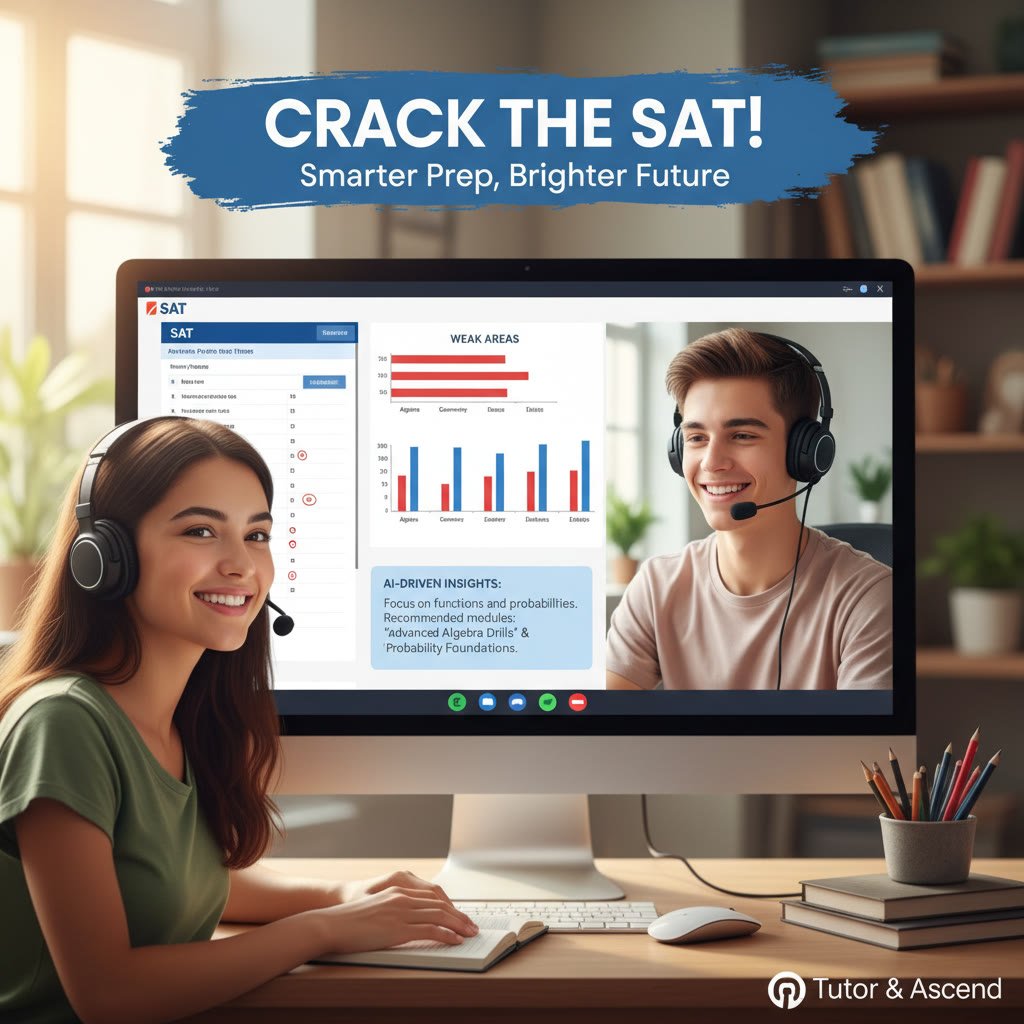The Role of Consistency in Student SAT Performance
When students ask me what single habit most reliably improves SAT scores, I don’t reach straight for secret strategies or miracle shortcuts. I point to consistency. Not dramatic, not flashy — just steady effort that compounds over weeks and months. If the SAT is a long road, consistency is the pair of shoes you actually want to wear.
Why consistency matters more than intensity
There’s a romantic appeal to the idea of an all-night cram session that produces a perfect score. In reality, cognitive science and decades of learning research tell a different story. Distributed practice — the idea of spacing learning out over time — improves retention. Retrieval practice — actively recalling information instead of passively rereading — strengthens memory traces. Both of these techniques thrive on consistency.
Here’s the practical upshot: doing high-quality SAT work for an hour every day for two months will generally beat a single marathon weekend of 12-hour sessions. Why? Because repetition with spacing builds durable skills: reading comprehension habits, algebraic fluency, and the mental stamina required to focus for three testing sections.
Consistency creates habit, and habit conserves willpower
Willpower is a finite resource during a busy school year. A consistent schedule turns studying into a habit, so you spend less energy deciding whether to study and more energy actually learning. That’s why many students who feel motivated at the outset burn out — they rely on motivation instead of structure. Consistency gives you structure.
What does consistent SAT practice look like?
Consistency doesn’t mean drudgery. It means a predictable, flexible rhythm you can keep. Here are elements of a reliable SAT routine:
- Short, focused sessions: 45–90 minutes of active study is often the sweet spot for high schoolers.
- Weekly practice tests: one full-length official practice test every 7–14 days, depending on where you are in your timeline.
- Daily micro-practice: 15–30 minutes of targeted practice or review each day (vocab in context, 10 math problems, or one reading passage).
- Small wins and weekly goals: track things you can control like completion of problem sets, not just score jumps.
- Recovery built in: planned light days to avoid mental fatigue and sustain performance long term.
Consistency with variety keeps your brain engaged
Consistency doesn’t mean monotony. Rotate tasks across reading, writing and language, and math. Use different resources: problem sets, targeted skills drills, timed sections, and review sessions where you analyze mistakes. The combination makes learning robust and prevents boredom.
Evidence-based techniques that thrive when used consistently
Here are practical methods that reward regular practice:
- Spaced repetition: revisit concepts at increasing intervals to lock them into long-term memory.
- Retrieval practice: close the book and explain a solution or recall vocabulary, then check accuracy.
- Interleaving: mix algebra, geometry, and data-analysis problems to improve transfer of skills.
- Reflective review: after each practice test, review every missed question and write a short summary of the error type and a plan to fix it.
Small examples, big effects
If you practice five geometry problems with attention and review their solutions every other day for four weeks, you’re more likely to internalize the problem patterns than if you attempt 50 problems in one frantic session. The key is recurring exposure and reflection.
Sample weekly schedule: a sustainable, consistent plan
Below is a sample plan for a student aiming to improve steadily over 12 weeks without burning out. This is a template you can adapt to classes, extracurriculars, and life.
| Day | Activity | Duration | Why it helps |
|---|---|---|---|
| Monday | Timed math section (one full section) + review of missed items | 75 minutes | Builds speed and identifies weak problem types |
| Tuesday | Vocabulary in context + grammar drills | 30 minutes | Maintains language precision with low time cost |
| Wednesday | Targeted concept review (e.g., functions, linear equations) | 60 minutes | Deep practice on a specific skill |
| Thursday | Reading passage practice + summary writing | 45 minutes | Improves comprehension and evidence-based answering |
| Friday | Mistakes notebook review + quick drills | 30 minutes | Reinforces correction patterns |
| Saturday | Full practice test every 1-2 weeks; otherwise split timed sections | 3-4 hours (test) / 90 minutes (split sections) | Builds stamina and simulates test conditions |
| Sunday | Light review and reflection; plan for week ahead | 30-45 minutes | Restores mental energy and keeps momentum |
An illustrative progress table
Below is an illustrative example showing how consistent weekly hours might relate to typical ranges of score improvements over roughly three months. This is an example, not a guarantee — progress depends on starting baseline, study quality, and the fit of strategies.
| Weekly Study Hours | Typical 12-week Improvement Range | Key Focus Areas |
|---|---|---|
| 3-5 hours | 10-30 points | Targeted weak-skill practice and consistency |
| 6-9 hours | 30-80 points | Regular timed practice, conceptual review, and error analysis |
| 10+ hours | 60-140 points | Frequent full tests, tailored interventions, and stamina building |
Measuring progress without obsessing over the scoreboard
Scores are important, but they’re lagging indicators. If you only focus on the number you might miss the real predictors of progress: how you study, how you review mistakes, and whether your practice builds durability. Here are better metrics to track week to week:
- Accuracy by question type (e.g., data interpretation, algebraic manipulation).
- Time spent per question type under timed conditions.
- Frequency of repeated mistake categories logged in a mistakes notebook.
- Quality of reflection after practice tests — do you write corrective steps?
When scores stagnate: a troubleshooting guide
It happens. Scores plateau despite regular effort. Instead of more hours, try smarter adjustments:
- Shift focus: stop doing the same practice and tackle the smallest recurring error type.
- Change format: if you always practice untimed, add timed sections; if you always work alone, add guided review.
- Get targeted feedback: a tutor or mentor can spot bad habits you don’t see.
How personalized guidance amplifies consistency
Consistency is easier when you have someone helping you calibrate effort and adapt strategy. That’s where personalized tutoring makes a difference. A good tutor or program doesn’t just give assignments — they tailor the plan to your strengths, track what truly matters, and keep you accountable.
For example, Sparkl’s personalized tutoring blends 1-on-1 guidance with tailored study plans and expert tutors who help translate practice into progress. Their approach includes customized schedules, regular check-ins, and AI-driven insights that highlight patterns across practice tests. That combination of human coaching and smart data nudges helps students make consistent choices that compound into real score improvements.
What effective tutoring looks like in a consistent system
- Clear short-term targets aligned with longer-term goals.
- Immediate, actionable feedback on mistakes.
- Accountability checkpoints so routines don’t drift.
- Tools to analyze trends so study time is invested where it moves the needle.
Case study: Maya’s quiet transformation
Meet Maya, a hypothetical but realistic example. She started with a baseline practice test score around 1100. Busy with classes and club activities, she could spare five hours per week. Instead of cramming, Maya chose consistency: 45 minutes on weekdays after school and a longer session on the weekend. Her routine included one timed section weekly, vocabulary in context daily, and a mistakes notebook she reviewed every Friday.
After twelve weeks she had improved to 1220. The number was nice, but the shift that mattered was method. She learned to read passages faster, identify algebraic patterns, and — crucially — to analyze errors and not just repeat problems until they felt familiar. When the pressure of senior year increased, her consistent habits made it possible to maintain progress.
Maya amplified her gains by working with a tutor who provided focused lessons on weak areas and suggested small schedule tweaks based on test analytics. That targeted, personalized support — the kind you get from a tutor who blends expertise with data — made her consistent practice far more efficient.
Practical tips to make consistency stick
Start with tiny commitments. Small successes build momentum much better than ambitious plans that are abandoned.
- Pick a non-negotiable daily window for SAT work, even if it’s only 20 minutes at first.
- Keep a mistakes notebook and review it weekly.
- Schedule practice tests in your calendar as appointments — treat them like real commitments.
- Set process goals (complete 3 reading passages today) instead of only outcome goals (raise score by 50 points).
- Celebrate micro-wins. Consistency is a long game and morale matters.
Tech and tools that support consistency
Timers, calendar blocks, and analytics dashboards can help. Some tutoring services include AI-driven insights that flag recurring errors and recommend exercises. If you use those tools, make sure they’re tied to a simple habit system — a dashboard is only useful when you act on what it tells you.
Managing motivation, setbacks, and burnout
Even consistent students hit rough patches. The difference between a temporary dip and a derailment is how you respond. Here are healthy strategies:
- Lean on your schedule: if motivation wanes, default to the habit rather than waiting to feel inspired.
- Take deliberate breaks: brief, planned rests improve long-term productivity more than sporadic indulgence.
- Use social accountability: study with a friend or check in with a tutor weekly.
- Re-evaluate goals: if progress is slow, ask whether study quality or methods need an update.
Putting it all together: a 4-week starter plan
Here’s a simple 4-week starter designed to create a consistency rhythm. It’s intended for students just beginning dedicated SAT preparation.
- Week 1: Establish a schedule. Do 30–45 minutes per day, focus on familiarizing yourself with the test format, and take one untimed diagnostic.
- Week 2: Add targeted drills. Do one timed section and one content-focused session each week. Start a mistakes notebook.
- Week 3: Increase retrieval practice. Add active recall sessions and attempt one full-length practice test under timed conditions on the weekend.
- Week 4: Reflect and adjust. Review your notebook, identify two recurring error types, and have a tutor or mentor help craft a focused plan for month two.
How tutoring accelerates these four weeks
A tutor shortens the learning curve by helping you prioritize the right work and avoid wasted hours. Sparkl’s model of 1-on-1 guidance and tailored study plans can be especially helpful in these early weeks, because an expert tutor spots the highest-leverage changes and the AI-driven insights highlight patterns you might miss on your own.
Final checklist: Consistency primer for SAT success
Use this short checklist to keep your practice grounded and sustainable:
- Daily micro-practice: 15–45 minutes.
- Weekly timed practice: at least one section under timed conditions.
- Mistakes notebook maintained and reviewed weekly.
- One full practice test every 1–2 weeks.
- Periodic review with a tutor or mentor to recalibrate strategy.


Parting thought: consistency is a compassionate strategy
One last note: consistency isn’t just about discipline. It’s about building an approach to learning that respects your life, your attention, and your long-term goals. It makes studying less frantic and more humane. If you approach the SAT with a steady rhythm, realistic goals, and smart feedback — whether from a skilled tutor or a well-designed program — you give yourself the best chance of improvement without sacrificing sleep, sanity, or joy.
Remember, improvement rarely comes in a single flash. It arrives quietly, through small practices repeated faithfully. Those small steps add up into big scores, calm confidence, and the skills that will serve you far beyond a test day.
Ready to make consistency work for you?
Start small, track what matters, and adjust with data. If you want guided support that pairs expert tutors with tailored study plans and AI insights, consider adding personalized 1-on-1 coaching to your practice routine. The right guidance makes consistent effort feel purposeful, measurable, and energizing.
You’ve got time, and the power of steady habits. Put them together, and the SAT becomes not a one-off trial, but a predictable outcome of the work you choose to do every day.
















No Comments
Leave a comment Cancel